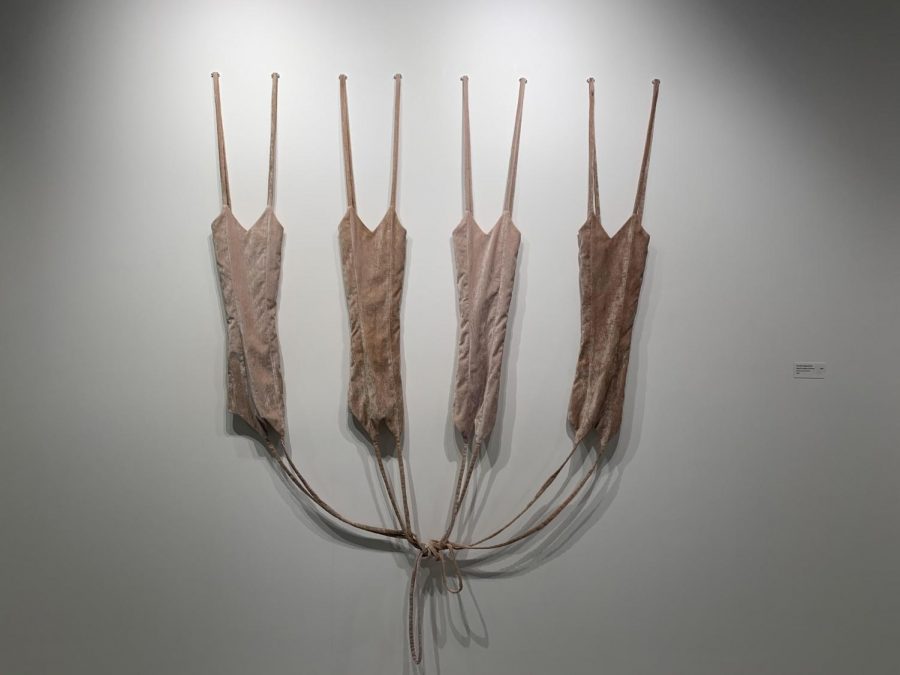From the classroom to the gallery
February 17, 2020
A loud, almost animalistic sound booms through the entirety of the Coburn Art Gallery upon entry. A glass container of hair, a hanging collage of prints and fabric ‘bodies’ hung to the wall are among the art pieces on display in the annual faculty art exhibit.
This exhibit highlights the work of the current Ashland University art faculty and gives students an opportunity to see the professional work done by these professors. The exhibit opened on Jan. 23 and runs through Feb. 23.
The five art and design faculty members that have pieces on display include Keith Dull, Priscilla Roggenkamp, Dan McDonald, Cynthia Petry and Michael Bird.
Many of the faculty members involved have been participating in this annual event ever since they began teaching at AU.
Dull, professor of art, has been submitting work to the faculty art exhibit since he began teaching at AU in 1999.
“In my view, the faculty exhibition is the most important exhibition I participate in during the year,” he said. “All of our students are expected to work towards a cohesive body of exhibition-ready work, and this show is an opportunity for my students to see me take a fragment of an idea and transform it into a finished body of work.”
A piece that Dull has up in the exhibit, titled ‘Correlation is not Causation 1968-2017,’ includes 50 different prints with each print depicting specific images to represent each year between 1968 and 2017.
“Memory and history have always been significant components in my work, and this was an opportunity to realign my own history, and seek out meaningful events and patterns,” Dull said. “Anyone who has lived through this time period is bound to recognize some of these images and events, and bring their own perspective to the interpretation of the images.”
Roggenkamp, who has four pieces on display, sees importance in being engaged in the very thing that she asks of her students.
“It is a sacrifice to carve out time to be serious about making art, or anything one is passionate about,” she said. “But that is exactly what we ask students to do.”
Roggenkamp’s pieces represent her current studio exploration and includes one in particular that utilizes clothing to depict ‘bodies’ hanging on the wall that are separately hung but intertwined at the bottom.
The piece is titled ‘(Not) Our Bodies, Ourselves’ and is “a symbol to illuminate issues of female agency of their own bodies,” Roggenkamp said.
Another artist with several pieces on display is Petry, the director of the Coburn Gallery. Petry’s work may come across as more abstract than some of the other pieces, as most of her art is done with found objects.
“You have to be partly a collector or have that instinct,” Petry said. “You have to also be willing to have tubs of things sitting around. You have to be willing to deal with the physical nature of having many items to pick from and if you can’t do that, then found object is not for you.”
From 19th century photos, to buttons, to human hair, Petry finds herself collecting any object that she thinks could become of use to her art.
“Found objects tend to be materials that we don’t think of as art materials the way that a painter might use paint and canvas,” Petry said. “I tend to find things that are already existing in culture and repurpose them.”
A large part of Petry’s inspiration comes from the 19th century and early 20th century photos of women that she collects. She has thousands of photos in her collection that have come from auctions, antique stores, buying them online or from people handing them over to her.
Besides using them in her art, Petry has found a niche for tracking down relatives of the women in the pictures and sometimes even returning those photos to the families.
“I think it’s the fact that you know it is connected to a real life, a family, a history,” she said. “It’s almost a compulsion for me when I see photos that have names and information. I have to do it and I want to get it connected whether or not I just end up making a tree on Ancestry if I can’t find a specific descendant, or even on Find a Grave.”
Even with the most minimal of information, Petry has been able to utilize her investigative skills to track down relatives of a family in a photo she received from the late 1800s. Using just first names, the city of the photographer and the individuals ages, Petry scoured the census until she found her match.
“It is rewarding,” she said. “I find it very interesting. Through censuses and other historical documents you can find out so much about their lives.”
Another unique item that Petry utilizes in her art is human hair. She said this interest came from her fascination with the Victorian era and their jewelry that used hair as a memorial for those they lost.
“I see it as a really powerful thing,” she said. “The way we see ourselves is by our appearance and that’s also rooted in our hair. It keeps it very personal.”
In terms of her art as a whole, Petry hopes the pieces she creates make the audience ask questions and think about topics they may not have thought about deeply before.
“I want people to ask questions,” Petry said. “Maybe someone hadn’t really thought about the women that came before them. Or maybe you hadn’t thought about your moms experience or your grandmother’s experience. Often times we don’t ask questions to our relatives or older people of what they experienced in their lives and how we might learn from that.”
To experience Petry’s pieces first-hand, do not miss her work and the works of the four other AU faculty members on display now in the Coburn Art Gallery.



